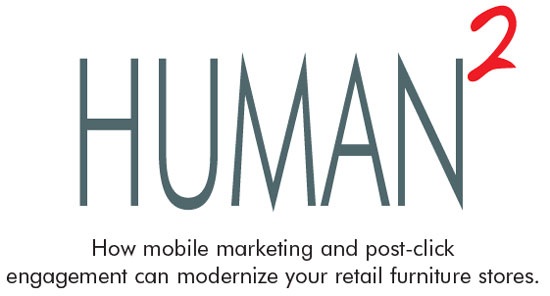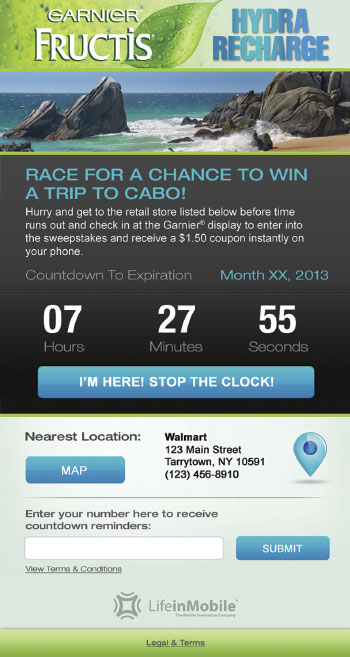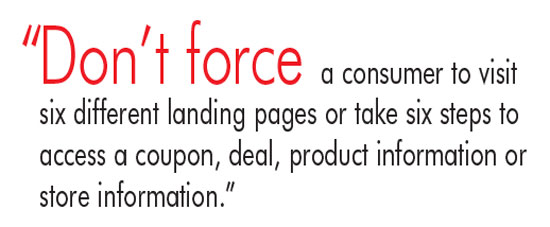
Consumers have changed and it’s not just due to economics or demographics. The rise of the smartphone, mobility and always-on accessibility have made them more aggressive and less patient. They demand quick and easy access to information, deals, and content along with the ability to react to it in an instant. Most of all, consumers want to understand the value a product or service will bring to their lives.
With this consumer evolution comes a new way to think about how to engage them online and off. We call it Human2, the theory is that as consumers spend more time on their devices, they actually become two selves -- one physical and one digital. This notion suggests that each of us exists in the real world and the digital world at the same time.
This duality has become a real challenge for furniture retailers that previously delved into mobile marketing by focusing solely on the type and functionality of devices. But today, using the theory of Human2, it is clear that marketers must do more. They must market to both the physical self that interacts with the environment, as well as the digital self that is connected to the Internet at all times via multiple devices.
With this challenge comes a huge opportunity for furniture retailers because they are well suited to take advantage of and maximize the power of Human2.
Mobilizing The Store
When shoppers visit your store to check out the features, service and pricing of your bedroom and dining furniture, they concurrently use mobile devices to try to learn more about products, find better prices at other retail stores or share their in store experiences with friends and family. The popular term for this is “showrooming” which many retailers fear is driving business away from their retail locations.
But this doesn’t have to be the case. Furniture retailers should engage and activate consumers to do something else with their mobile devices while visiting their stores. This means mobilizing the entire store by doing some of the following:
- Add QR codes to every furniture hang tag to direct shoppers’ attention to information you WANT them to see.
- Post “text-in” codes on select pieces for exclusive content or deals.
Control the Message
By mobilizing the store, you can control the message and information.
Salespeople are probably the most important asset in retail furniture environments and are key to mastering the theory of Human2. That’s because they can see what shoppers are looking at in real time. They can talk to shoppers about what they like, and most importantly, see when consumers are using their mobile devices in-store.
This is the point of contact where you can empower your salespeople to increase sales. To do this, however, you must be willing to provide them with their own, corporate mobile devices so they can text or email in-store only deals and coupons, check inventory and conduct price comparisons. Even more important, that device should serve as a “register” where shoppers can purchase their furniture. In today’s digital age, a shopper should never have to visit a sales counter. The time a shopper spends walking to the sales counter is more time they have to think about not making that purchase.
As your sales teams become more “Mobilized” and engaged in the showrooming process, it’s equally important that furniture retailers be as transparent as possible when it comes to pricing. We know consumers check their mobile devices for better prices while in your store, so why not control that process. Offer them the price comparison, show them your price and tell them why buying from your store is their best option. Make the decision for them.
 |
This Garnier "Race to Retail" program focused on driving consumers to retail by delivering a mobile coupon that had to be redeemed within a certain amount of time. |
“Mobilize” Your Marketing
As you are “Mobilizing” your store, also consider how you will take advantage of Human2 to get more traffic in the door.
Most retailers already learn a lot about their customers from digital metrics, including information about who is activating ads (when, where and how often) in a pre-click environment. But this data is limited in its ability to help retailers maximize and optimize the ROI of their ad spends.
In a Human2 world, the action taken by a consumer and the data provided to a retailer following clicking on an ad or link is the difference between marketing success and failure. For furniture retailers, taking advantage of this post-click world means leveraging a new strategy called post-engagement conversion optimization.
Post-Engagement Conversion Optimization
Post-engagement conversion optimization is the process of tailoring the post-click user path a consumer takes after an initial click on an ad or marketing link. This customized journey needs to be based on what’s affecting a shopper at the moment of engagement, taking into account their environment as well as factoring in information about how that consumer has interacted with your brand in the past.”
So how does a retailer optimize their advertising and marketing campaigns to maximize the post engagement conversion opportunity?
Location, Location, Location
First you must engage a location based service or application to ensure you know as much about the consumer's’ environment as possible as you attempt to engage. These services give a view where a person is, as well as what’s happening where they are, with one relevant aspect being the weather. This can be important for retailers who service large trading areas. To know if it’s raining, snowing or unseasonably cold can help you deliver the most relevant and impactful message in real time. This is essentially the same tactic as a store leaving its doors open on a hot day to allow the cold air out onto the street or Cinnabon strategically placing all their locations so the sweet smell of sticky buns permeates an entire mall.
Better yet, you can use location for more than the weather. Understanding where a consumer is at any given moment allows you to use that location to anticipate where he or she will go or to direct them to a particular retail location. A unique way to connect with an in-store consumer is by offering free wifi. This allows you to provide a great value added service, and directly deliver in-store promos and coupons.

Time of Day
Next, always consider the time of day. Sounds obvious, but you can’t control when a consumer will click on an ad, but you can control the experience based on the time of day when they do. Provide in-store coupons and deals during the times when consumers are most likely to visit your store. It may make more sense to deliver an email with a $100 off coupon at 11pm on a Sunday night in order to drive foot-traffic on a typically slow Monday, rather than 11am on a Saturday, as the weekend will likely be busy anyway.
Relevant & Immediate
Finally, make sure your message is relevant and immediate. Don’t force a consumer to visit six different landing pages or take six steps to access a coupon, deal, product information or store information. The less clicks and the more rapidly a shopper can engage with your brand, the better.
Conclusion
In the end, furniture retailers and brands need to recognize that consumers are smarter than ever before and more digital than any of us could have imagined. This means in order to not just compete, but to win the battle for consumer mindshare and dollars, we must factor in everything that makes up the physical and digital consumer - the Human2 - no matter where they are.
About John Lim: John Lim, Founder & CEO of Life in Mobile. John assumes many roles as CEO of Life in Mobile; but of all the tasks that he may face in a single day, the number one challenge on Lim’s mind, is how to empower others, and make great ideas come to life.
He left college at 19 to found his first company, Global Telcom, which rapidly rose to be the fifth-largest mobile phone distributor in New York City. At 24, Lim created On Site Marketing, a full-service marketing agency which pioneered the use of Short Message Service (SMS) to drive engagement in marketing campaigns for clients including Anheuser-Busch.
After experiencing the possibilities of the mobile market, Lim launched Life in Mobile, a dedicated mobile agency that developed and launched Mobile Real Estate and Win Local®, two platforms that help realtors earn new business and compete with emerging online real estate mega-sites.
Lim attributes his success to his Human2 theory – recognizing the human behind the device, and not the device itself – and applies this thinking to all of his work. LifeInMobile’s soon to be released linknexus™ solution will take the Human2 theory to a new level by giving companies the ability to create one-on-one experiences on a massive scale.
Following his passion for empowering others, Lim, an accomplished speaker, has presented at over 50 events and travels the world inspiring audiences on how to best embrace the future of mobile. Questions about post click conversion optimization can be directed to him at info@lifeinmobile.com or call 914.909.6701.
Furniture World is the oldest, continuously published trade publication in the United States. It is published for the benefit of furniture retail executives. Print circulation of 20,000 is directed primarily to furniture retailers in the US and Canada. In 1970, the magazine established and endowed the Bernice Bienenstock Furniture Library (www.furniturelibrary.com) in High Point, NC, now a public foundation containing more than 5,000 books on furniture and design dating from 1620. For more information contact editor@furninfo.com.